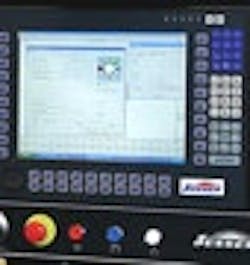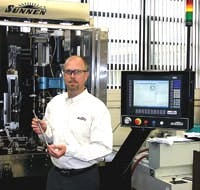A Future Built on the Past
By Mike Bacidore, Managing Editor
Sunnen Products is a typical mid-sized multinational machine builderapproximately 700 employees in nine countries, including the U.S., Poland, Russia, China, Switzerland and the U.K. Headquartered in St. Louis and still privately owned after more than 80 years in business, Sunnen employs about 70 mechanical, electrical, ceramic, industrial and manufacturing engineers worldwide.
While many OEMs are looking to capitalize on the attractiveness of U.S.-made machines due to a weak dollar, Sunnen has a history behind building a global business. Sunnen's export sales are just over 50% and always have been one of the company's strengths, says Russ Jacobsmeyer, the companys CTO. Europe and Asia are particularly strong, and sales have been growing at an annual rate of 10% for the past several years.
HONING IN ON PRECISION
Russ Jacobsmeyer, Sunnen chief technology officer, holds a diamond-plated honing tool as he stands near an SV-1000 multi-spindle honing machine with air gaging, used to produce precision parts for the hydraulics industry.
What helped Sunnen accumulate such a storied past is its ability to always look to the future. Remote diagnostics and lean manufacturing already have found their way into Sunnen, and newer technologies and principles are on the radar.
Sunnen's corporate mission is to improve the performance of our customers," says Jacobsmeyer. The company offers an extensive range of pre-sale and post-sale support and training services to customers. The most obvious use of new technology in the service arena is remote diagnosis of machine problems via PC, making subsequent service calls either unnecessary or much more effective. Recent lean manufacturing initiatives have slashed the order-to-delivery cycle for everything from spare parts and abrasives to new machines. Although the company offers more than 12,000 different abrasives and has 115,000 active part numbers, on-time shipments average above 95%.
The latest DC servo motor/drive combination units top the list of new technologies at Sunnen. The major engineering requirements for three machine platforms recently developed were the flexibility to use servo control in any axis of motion, including the stroking system, spindle rotation, tool feed system, machine movements and part indexing systems, depending on the model, explains Jacobsmeyer. Servo stroking in a honing machine is a significant engineering issue. Honing machine designs traditionally have used a hydraulic drive or a four-bar linkage. The spindle mass has to be accelerated and decelerated through extremely high velocities at each reversal point.
Sunnen used a new servo-driven, ballscrew-stroking system in its new machines. It has proven exceptionally reliable and accurate, says Jacobsmeyer. Currently patent-pending, this stroking system is far more precise and controllable than a hydraulic drive, approximately 400% more accurate. We wrote the motion profiles for the stroking system, which is closed-loop-controlled. This high-precision motion control allows the user to tailor the spindle action to optimize the honing process, not unlike a craftsman would do in a manual process.
Functionality, cost and part count are driving innovation into Sunnens controls and automation designs. A key issue going forward is how you design a machine that's capable of working to tolerances of ten-millionths of an inch but needs to be operated by someone with a very low skill level, says Jacobsmeyer. Major issues we are trying to address to achieve this are total system automation, feedback loops and multi-language capability in controls. Sunnen is designing more icon-based, PC-like HMIs that are most familiar to operators, he says.
While Sunnen manufactures machining systems for precision bore sizing and finishing, its vertical integration lets the company control all R&D, manufacturing, service and support of its products, including specialized abrasives and tooling. More important, it allows development of end-to-end processing systems that are custom-designed and single-sourced to ensure they meet customers' required quality and production levels, says Jacobsmeyer. Our core technical competencies include R&D and manufacturing of machining systems, tooling, abrasives, lubricants and gaging, along with high-production turnkey system integration.
Today's CNC-controlled honing systems can correct a multitude of errors in bore geometry, such as barrel, taper, centerline bow, roundness and straightness, explains Jacobsmeyer. Computer-controlled machines can achieve sizing accuracies of ±0.000010 in. or 0.25 µm, he says. One of the keys to the performance of many products is the crosshatch pattern produced on the bore surface by honing. The honed finish combines a specific quality of bearing surface with a defined crosshatch pattern that enhances axial lubrication transfer.


